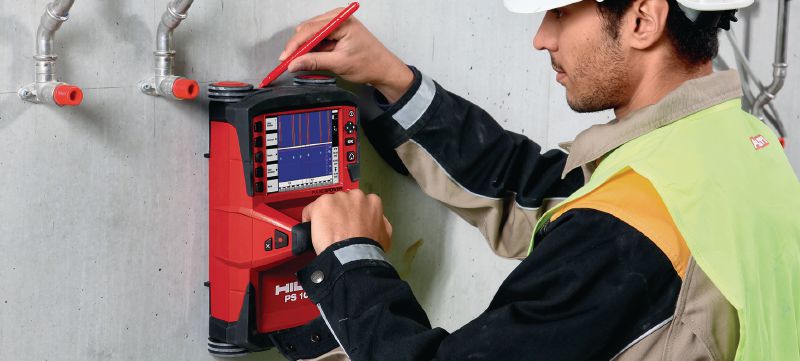Advanced RainierGPR Concrete Scanning Providers Revealed
Checking Out the Depths: A Comprehensive Overview to Concrete Scanning and Its Diverse Applications
In the world of building and facilities advancement, the careful procedure of concrete scanning holds a crucial duty in making sure the architectural integrity and security of projects. As modern technology continues to develop, the applications of concrete scanning have actually expanded much past simple surface-level evaluations. From identifying rebar and post-tension cable televisions to mapping out gaps and conduits concealed within concrete frameworks, the capacities of modern scanning techniques are both crucial and excellent. However, real deepness of concrete scanning's potential reaches even better, branching into unanticipated industries and triggering cutting-edge options. The interconnected internet of opportunities that concrete scanning offers is not only interesting however additionally vital for the advancement of various industries.
Value of Concrete Scanning
Understanding the relevance of concrete scanning is crucial in making certain the safety and honesty of frameworks during construction and restoration tasks. Concrete scanning makes use of innovative modern technologies such as ground-penetrating radar (GPR) and electromagnetic induction to detect ingrained things, voids, or various other abnormalities within concrete frameworks.
Furthermore, concrete scanning plays a crucial duty in ensuring conformity with building codes and laws that mandate the security of existing architectural parts during construction activities. By precisely mapping out the interior composition of concrete, scanning technologies allow construction specialists to make educated decisions that promote the architectural stability and resilience of structures and infrastructure jobs. Essentially, the relevance of concrete scanning hinges on its capacity to protect both the structural honesty and the personnel associated with construction undertakings.
Technologies Made Use Of in Concrete Scanning
Concrete scanning counts on sophisticated technologies such as ground-penetrating radar (GPR) and electromagnetic induction to accurately find embedded objects and abnormalities within concrete frameworks. Ground-penetrating radar runs by discharging high-frequency electromagnetic waves into the concrete.
Electromagnetic induction, on the other hand, works by generating electro-magnetic fields around a concrete structure via a transmitter coil. When steel objects are existing within the concrete, they disrupt these electromagnetic areas, triggering eddy currents to stream with the metal. By determining the adjustments in the magnetic fields with a receiver coil, the system can pinpoint the location of metallic things in the concrete.
These advanced technologies play a vital function in non-destructive screening, making certain the safety and integrity of concrete frameworks in different industries.
Applications in Building Sector
Within the building market, concrete scanning modern technology locates diverse applications that improve job efficiency and safety. Furthermore, concrete scanning is made use of for situating gaps, such as air pockets or locations of wear and tear within concrete, which can compromise the overall toughness of a structure. Concrete scanning plays a vital role in high quality control by confirming the thickness of concrete covers over reinforcement, ensuring conformity with layout specs and standards.
Safety Benefits of Concrete Scanning
In the world of building and construction safety and security, the application Go Here of concrete scanning modern technology presents a vital benefit in preemptively determining potential hazards and strengthening structural honesty. By using advanced this link scanning approaches such as ground-penetrating radar (GPR) and electro-magnetic induction, building and construction teams can properly situate rebar, post-tension wires, channels, and other concealed objects within concrete structures. This positive approach significantly reduces the threat of unintentional strikes throughout boring, reducing, or coring tasks, consequently protecting against costly problems, injuries, and task hold-ups.
Moreover, concrete scanning boosts worker safety by offering real-time information concerning the architectural condition of concrete elements. This data makes it possible for building specialists to evaluate the stability of existing structures, identify wear and tear or issues, and make informed decisions concerning repair and maintenance procedures. By addressing potential security problems quickly, concrete scanning adds to creating a safe working atmosphere and alleviating the likelihood of architectural failures or mishaps on construction sites. Ultimately, the security advantages of concrete scanning not only guard properties and lives however also support sector requirements for quality and reliability.
Future Trends in Concrete Scanning
Emerging improvements in scanning innovation are positioned to transform the field of concrete assessment and analysis. By using the power of AI, these systems can analyze huge amounts of data collected throughout scanning processes to give even more comprehensive and exact understandings into the problem of concrete frameworks.
One more substantial fad is the development of more mobile and easy to use scanning tools. Miniaturization of scanning equipment allows for less complicated accessibility to confined areas and remote places, making evaluations more reliable and detailed. Additionally, innovations in wireless interaction technologies make it possible for real-time data transfer and evaluation, assisting in quicker decision-making processes.
Additionally, there is an expanding concentrate on sustainability in concrete scanning modern technologies - RainierGPR Concrete Scanning. Manufacturers are significantly integrating eco-friendly materials and energy-efficient features into their gadgets to decrease ecological impact. These future patterns are set to enhance the effectiveness, accuracy, and sustainability of concrete scanning techniques, shaping the market's future landscape
Final Thought
To conclude, concrete scanning plays a critical role in the construction industry by making sure the safety and security and performance of numerous jobs. By making use of sophisticated modern technologies, such as GPR and radar imaging, specialists are able to properly discover potential risks within concrete structures. The applications of concrete scanning are large and remain to evolve, making it a vital tool for keeping the stability of buildings and facilities. As innovation developments, the future of concrete scanning holds encouraging developments for improving building and construction processes.
